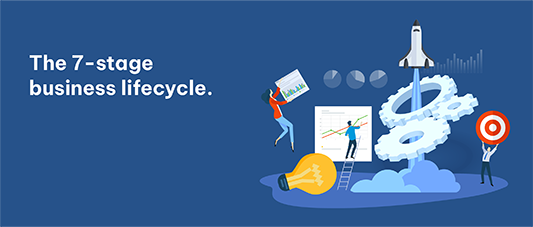February 1, 2024
The 7-stage Business Lifecycle
What Is a Life Cycle?
A life cycle is a course of events that the business goes through gradually from the first day of its existence and follows its growth into a mature business and eventual critical mass and decline. This progression can be categorised into 7 primary stages: (1) Seed Stage, (2) Startup Stage, (3) Growth Stage, (4) Established Stage, (5) Expansion Stage, (6) Decline Stage and (7) Exit stage (Zahorsky, 2019).
Seed Stage
During this stage, you would primarily engage in various ideation processes, including (1) determining the overall direction of the business and (2) conceptualising the ideal product/service. This stage is primarily characterised by market research and analysis - serving as the foundation on which your entire business and strategy are built. Ultimately, this stage aims to answer the who, what, how, when, and where questions mentioned earlier.
Startup Stage
During this stage, you would engage in various production processes, including (1) developing your product/service offering, (2) building your business platforms and (3) launching your product/service into a well-researched market. This stage is primarily characterised by business launch strategies, including acquiring initial customers and embedding various processes to ensure the offering reaches the intended consumer - in other words, sales, and marketing.
Growth Stage
During this stage, you would identify various growth indicators, including an increase in (1) revenue streams and (2) customer base, as well as a need for (3) additional resources to support and maintain the growth trajectory of your business. This stage is primarily categorised by the movement towards the break-even point - meaning the business can cover its initial startup costs and start generating a profit.

Establish Stage
This stage is characterised by an overall sense of stability, including a stable (1) market position, (2) customer base and (3) revenue streams. The business has typically moved beyond its break-even point, meaning that a substantial/cumulative profit is generated and injected into the business to support further growth and overall enhancements throughout.
Expand Stage
This stage is characterised by the identification of various expansion opportunities, including the expansion of the (1) business investment, (2) market segments, (3) offering assortment, and (4) human resources. This stage is primarily characterised by additional investment and resource acquisition, as well as the procurement of innovative technologies to support the overall improvement and expansion of the business - specifically platform functionality.
Decline Stage
This stage is characterised by a dramatic decrease in your (1) customer base, (2) revenue streams, and (3) competitive strength. Typically, a business would reach this stage if the entrepreneur doesn’t (1) adhere to the changing demands of consumers, (2) leverage the benefits of innovative technologies or (3) constantly conduct market research to improve overall. Usually, the business can be salvageable if the correct enhancements throughout the business are prioritised.
Exit Stage
When reaching this stage, you would decide to either (1) sell the business to another owner or (2) close the business completely. this stage is reached, you’ll typically be faced with the time-tested reality: The possibility that your initial foundation for the business wasn’t designed to support overall business growth. In other words, you didn’t (1) conduct thorough market research or (2) create an agile and scalable (a) business plan, (b) business model and (3) market offering that was able to leverage and adapt to various changes within and around the business.